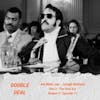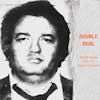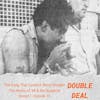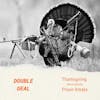
The Nite Lite

The 1966 slayings of Tash Bratsos and Tommy dePrisco were the catalyst for Joe Barboza becoming the FBI's star witness in multiple cases against the Boston Mafia. This week we're profiling some of the men who frequented Ralphie "Chong" Lamattina's Nite Lite, including those who were allegedly responsible for the murders: Phil Waggenheim, Larry Baione, and Joe Black.
Plus, special appearances by Dominic "Red Hogan" Ciambelli and the Palladino brothers.
Follow us on Twitter for sneak peeks of upcoming episodes. You can also find us on Instagram and Facebook.
Questions or comments, email lara@doubledealpodcast.com or nina@doubledealpodcast.com
Donate to Lara and Nina
Thank you for listening!
All the best,
Lara & Nina
Lara:
Hi everyone! In last week's episode we discussed the gangland slayings of 1966. One person in particular, Ilario Zannino aka Larry Baione was on Stevie Flemmi and his crew’s hit wish list, but Stevie was unable to take out Larry with a bullet. Instead it would take two decades for Stevie to exact his revenge, not with a gun but rather through Stevie’s cooperation with the Feds. The dreaded wiretaps would be Larry and many others’ undoing.
Nina:
You think they would have learned their lesson in the ‘60s with the wiretaps at Raymond Partiarca’s office and Jerry Angiulo’s lounge!
Lara:
Well, obviously not!
In today’s episode we’re going to be profiling Larry’s early days through the 1960s along with the men who frequented the Nite Lite Lounge in the North End of Boston. The events at the Nite Lite on November 14, 1966 were supposedly the catalyst for Barboza flipping and becoming a government witness. More like a government tale teller.
Nina:
Don’t sugar coat it! The man was a pathological liar! Just like everybody else the Feds put on the stand!
Lara:
No shortage of those incidents in these stories!
Nina:
That’s why “lies” is part of the name of this podcast!
We’ll also be discussing some of the other men who were Boston LCN members, associates and of course an informant or two.
Lara:
What would Boston Organized Crime be without a few informants?
Nina:
Let’s face facts, there were more than a few. As we’ve mentioned before, according to the list of FBI informant numbers it seems as if there were more informants than criminals.
Lara:
And that’s not including those informing to the BPD!
Nina:
And the State Police, particularly Cornelius Crowley.
Lara:
And half of them were on the take.
Nina:
The wiretaps from the ‘60s confirm that.
Let’s start with Larry’s background. Ilario Antonio Maria Zannino was born on June 15, 1920 to Isabella La Gratta Baione and Joseph Zannino. Isabella had four sons from her previous marriage: Louis, Frank, Peter and Phillip. Like many of the other men we’ve been discussing, Larry boxed in his teens. On his draft card from 1941 he was listed as a farmer employed by Louis Baiona.
Lara:
I told you they had a pig farm!
Nina:
It wasn’t the pig farm I had a problem with. What was so disgusting was that Larry may have fed James Bratsos to the pigs!
Lara:
Awful, but considering Bratsos has never been found, it’s not so far-fetched.
The shootout with James Bratsos in 1951 is the first arrest of Larry that I could find. At that time he was known to have been hanging around with Anthony Santaniello, Henry Selvitella, Frank Cucchiara and Joe Lombardo.
Nina:
Listen to episode 11 if you want to hear more about them. Larry was also working with Sammy Granito, Ralphie “Chong” Lamattina and of course Jerry Angiulo. Illegal gambling was believed to have been his primary source of income.
In May of 1954, Larry’s father, Joseph passed away. The following month, Larry’s mother’s car was found burning in Lynnfield. She said she left it parked on Hudson St. near her Harrison Ave home in the South End of Boston. Revenge for the disappearance of James Bratsos?
Lara:
More likely Larry had it stolen and torched for the insurance money. A pretty common thing in those days.
In June of 1960, Larry was arrested along with Leo Santaniello, Phil Waggenheim, Richard “Red” Assad and Edward Franks for what the authorities dubbed a “pay or die” scheme. They were shaking down business owners offering protection. If the businessmen didn’t pay up they were threatened and eventually beaten. When Red Assad was picked up he had brass knuckles in his pocket.
When they appeared in court on June 29th, Larry was called the head of the New England Crime Syndicate by the assistant DA.
Nina:
Everyone was “head of the New England crime syndicate” according to the ADA.
Lara:
Hey they would have gotten it right eventually!
Back to Larry. Bail was set at $25,000 for him, $50,000 for Santaniello and Red Assad was freed on $1000 bail.
The following month Larry’s wife showed up at the Charles St. Jail with a bag filled with $25,000 dollars in small bills to bail him out.
Nina:
Oh, that must have pissed the guards off!
DA Garrett Byrne tried to block the acceptance of the money demanding that a bondsman guarantee the bail, but Larry was released. Leo made it out a few days later. Phil Waggenheim wouldn’t be behind bars much longer either. On August 11th, Mrs. Waggenheim arrived at the jail accompanied by Phil’s attorney Lawrence O’Donnell. Phil’s wife was toting a brown paper shopping bag filled with $50,000 cash! Byrne called in Secret Service agents to examine every bill to ensure that none were counterfeit and that none of the serial numbers matched any money from bank or armored truck heists. Much to Byrne’s dismay he had to cut Phil loose.
Lara:
Can you imagine!
In December Larry, Phil and Leo pleaded guilty to the extortion charges. They were each sentenced to four to seven years in State Prison. Larry’s mother passed away on March 21, 1963.
Before we go further in Larry’s story, let’s talk about Phil Waggenheim, another one of my favorite childhood story characters.
Nina:
Philip Waggenheim was born on February 2, 1915 in Boston to Barnet Waggenheim and Rachel Zand. Phil had seven siblings, and a few were also on the wrong side of the law including two of his sisters.
His parents and older siblings had immigrated from Lithuania in 1905. Phil himself almost wasn’t even born. In 1913 the family almost died of asphyxiation when someone forgot to open the damper on the stove. But thanks to a quick-thinking cop, the family were all saved, and Phil was born two years later.
Lara:
I know this is a tangent, but we have to tell the story about Phil’s oldest sister. On February 12, 1921 Harry Baer and Rose Waggenheim were arrested during a raid on a West End apartment. Harry announced to the judge that they were man and wife. Aftering wishing them the best of luck and congratulating Harry on his fine taste, the judge filed the case. Harry went on to explain that he had been keeping company with Rose since she was 15, and that they had just received a marriage certificate. Off they went to the justice of peace to be wed happily ever after.
Nina:
Ever after is a bit of a stretch. She remarried three years later. Rose wasn’t the only sister to be arrested. Another sister was locked up in the Framingham Women’s Prison in the 1930 census, but I couldn’t find what she was actually convicted of. And Phil’s older brother Nathan was locked up in Pennsylvania in the 1920 census. His mother reported him missing in April of 1924, and it appears he was never found. Clearly the family were just degenerates.
Lara:
Definitely some issues there.
The first arrest for Phil that I could find was in December of 1933. He and another man were arrested for passing counterfeit $5 bills. Then in March of 1935 Phil was arrested for stabbing Allen J. McDonald to death. George Ayoub was arrested with him. The stabbing occured after an argument between the men. By the way the picture of Phil with his ‘stache from that arrest is great! Later that month both Phil and George were found not guilty of murder, but sentenced to four months for assault.
Nina:
Phil got lucky there. Or he paid somebody off!
He got married to Dorothy Pacifico on April 20, 1938 in New Hampshire, but the marriage does not seem to have lasted very long because by 1940 the couple were back living with their parents, and Phil was working for the Mystic Automatic Sales Company. Another vending machine company like Raymond Patriarca’s Coin-O-Matic.
In September of 1941, Phil enlisted in the Army. But once he returned home he was back to his usual routine. In April of ‘46 Phil was charged with illegal gun possession and assaulting boxing manager, Jacob Cutler. The case was dragged out until 1948, but by then Domenic “Red Hogan” Ciambelli had already been convicted of shooting Cutler. Although Phil didn’t actually do anything to Cutler, witnesses including Cutler said that Phil was the one who passed the gun to Red Hogan.
Lara:
Finally, Red Hogan!
Nina:
I know, another one of your favorite childhood characters.
Lara:
You know it usually wasn’t the content of the stories that caught my attention, but the names and the way the guys would pronounce them.
Nina:
Too many Reds to keep track of for me. I still can’t remember the last name of the one who got killed by his in-laws in the barroom. Before we move onto Red Hogan’s background, let's go a little further with Phil’s. In 1949, the Feds pinched Phil and four other men for hijacking a truck full of nylon stockings. Nothing ever came of that case, but in October of that year his brother Israel’s apartment on Blue Hill Ave. in Roxbury was the scene of a fire. In the apartment was their 83 year old mother. No one was hurt, but the building was severely damaged.
Lara:
As we mentioned earlier in June of 1960, Phil was arrested along with Leo Santaniello, Larry and Red Assad on extortion charges and later that year they were sentenced to four to seven years in prison.
Now can we talk about Red Hogan?
Nina:
Yes! We'll pick up Larry and Phil when they’re released from prison.
Domenico “Red Hogan” Ciambelli Jr. was born in Newton on May 23, 1913 to Assunta Barone and Domenico Ciambelli Sr. Domenico was from Campania and operated a drug store in Newton. He passed away from an epileptic seizure the following December, leaving behind Dominic and his four older siblings.
Dominic’s older brother, Carl, was also involved in crime. Mostly bookmaking. The first arrest we found for him was in November of 1934 for running an illegal gambling pool.
Like many of these men, Dominic was a boxer. Phil Bruccola managed him in the 1930s under the name, “Red Hogan”. The Hogan name came from Phil’s wife’s side of the family. Phil had also taken his wife’s fatherless nephew, Richard Hogan, under his wing. Richard was about the same age as Dominic, and would act as his uncle’s courier for decades, traveling to Italy to deliver messages and payments between New England and Sicily.
Lara:
In August of 1943, Domenic was arrested in New York and extradited back to Boston to face charges for a shooting at the Latin Quarter Nightclub. Joseph Palladino and James Guerriro had been shot and wounded in March of the same year.
Nina:
I was unable to find a connection between Joseph Palladino and Robert Palladino, who was killed by Johnny Martorano in 1965, but Joseph was the older brother of Rocco Palladino.
Lara:
Race horse Rocco that used to own Moakley’s on Tremont St in Boston?
Nina:
Yes, racehorse Rocco, but I don’t know about his activities as a restauranteur! You know one of his horses was named “Little Beans”, and it ran at the Kentucky Derby in 1941 placing 5th. Rocco’s nephew Joe Jr. had the same nickname.
Lara:
How sentimental!
Nina:
Yeah, ok.
I want to tell more of the Palladino story, so you’re going to have to wait a little longer for more about Red Hogan.
Lara:
I’ve been waiting for 38 episodes, so what’s a few more minutes.
Nina:
First, I want to revisit one of the murders from 1965. I know I mentioned in the Hit Parade of 1965 that FBI SA Kehoe’s report to the US Attorney’s Office in Boston was trash, but I want to underscore that fact again here. Kehoe’s investigation failed to mention that Peter Cassetta, who was murdered by Jimmy Flemmi, was the nephew of Rocco Palladino. This is the same FBI Agent who was ready to go and exhume a 50 year old grave to find out if Philippo Sacco and John Rosselli were the same person, so I don’t buy that Kehoe was unaware of that important detail.
Lara:
We’ve both questioned multiple times whether the FBI’s omission of information in their reports was deliberate or ignorance.
Nina:
I have to say deliberate. They were after bigger fish and were afraid these other cases would interfere with their ability to take down Patriarca and the so-called “Italian element”. But as we’ve stated in previous episodes, that decision led to them allowing serial killers to roam free for decades, terrorizing Boston and the surrounding area.
Now some background on Rocco Palladino. He was born in April 1906 to Nunzio Palladino and Lotteria LaRosa. His older brother, Joseph, also known as “Joe Beans”, was born in January 1899.
In July of 1925, 18-year-old Anthony Cassetta, Peter’s father, shot himself in the left cheek while he was visiting Rocco. He said that he didn’t realize that Rocco’s pistol was loaded.
Lara:
Who puts a pistol to their own face?
Nina:
The men we’re covering in this podcast, that’s who! They were all degenerates!
In October of 1933, Rocco was present at another accidental shooting. This time his companion Peter Amorosa turned up with a bullet wound to his hand. Rocco and he were arrested for being suspicious persons. They claimed to have found the gun on the street.
Lara:
Sure, it was just laying there on the sidewalk.
Nina:
It’s possible!
The murder of Arthur Suprenard led to Rocco’s next arrest in March of 1935. The police used two old motor vehicle violations as the reason to bring him in for questioning.
At the time Red Hogan supposedly shot Joe Palladino in 1943, Joe was out on $8000 bail for his alleged involvement in a “fictitious lottery” with Doc Sagansky. Doc had already pleaded guilty to the charges and was sent to state prison for 2 ½ to three years. Palladino was scheduled to return to court the day following the shooting.
I buy that Red Hogan was half in the wrapper when the shooting happened, but the timing sure was convenient for Palladino. The story goes that there were five of them in the club sitting at the same table. They got into a heated argument supposedly over a woman. Red Hogan goes to the restroom to “cool off”.
But then a police detective reported that the two men who had been shot had really only been grazed by the bullets that were fired. Palladino had been shot in the right hand. Guerino in the right elbow. But there was so much blood that it looked like a third man had been stabbed, but the cops couldn’t find him.
Lara:
I’ve got a Rocco story. In March of 1951, Rocco testified in front of a Federal Grand Jury in Los Angeles along with Max Chipman. They were both suspected of being associates of Mickey Cohen. Rocco supposedly was one of four men who lent Cohen $300,000.
Rocco’s response was, “He must mean some other Boston Rocco Palladino.”
Rocco also claimed that he’d “never made book” or “violated the law in the 20 years I’ve been a Boston businessman.”
Nina:
Max Chipman, who was related to Phil Waggenheim, was also suspected of kidnapping Herman Rutstein of Dorchester back in 1932. The ransom was $40,000. Rutstein was found unharmed next to the grave his kidnappers forced him to dig. Joe McGinnis from the 1950 Brinks job was also supposedly involved in that adventure.
Ok, I’ll let you get back to Red Hogan.
Lara:
While Red was waiting to see if he would be indicted for shooting Palladino and Guerriro, he was arrested on pimping and pandering charges in October of 1943. The following month he was indicted and held on $25,000 bail. But not for long. While he was roaming the streets he shot boxing promoter, Jacob Cutler, as we mentioned earlier. Judge Elijah Adlow called Red Hogan “a menace” and held him on $20,000 double surety. The judge also questioned why nothing ever came of the indictment in the Latin Quarter shooting. The prosecutor explained that there were no witnesses. In the end Red was never tried for that shooting, and would eventually be cleared of those charges in 1949. But he was sentenced in the Culter shooting. In the meantime Cutler himself was charged with perjury.
Nina:
In April of 1947, Red was on trial in Federal Court for hijacking a truck with $40,000 worth of liquor in it. He was sentenced to five years in prison, and was already serving four to five years in state prison for the Cutler shooting. And that brings us to one of my favorite Red Hogan stories! He actually had the nerve to ask the judge for a month-long summer vacation between the sentences.
Lara:
Was the judge sympathetic?
Nina:
No! And of course when Red Hogan was back on the streets he fell right back into his old routine. In June of 1957 he was arrested along with Carl Sasso while trying to break into a milk plant in Connecticut. In October of that year Red was sentenced to two years in prison, but was paroled after 18 months just in time to be back on the streets when Angie DeMarco was killed. Red was considered “a key witness” by the authorities when DeMarco’s dead body was found in an Everett dump in 1959. The night DeMarco was killed he was seen having dinner with Red, and given Red’s history it’s no surprise that he landed on the suspects list.
Lara:
DeMarco’s murder was never solved and Red continued to find trouble everywhere he went.
In November 1961, he shot Anthony Indelicato while in the Crawford House at 1:30 in the morning. Indelicato was hospitalized in critical condition. Indelicato was a cousin of Teddy Deegan’s brother-in-law and therefore also a cousin of the New York Indelicatos who were with the Bonnano Family. Both men denied that Red Hogan was the shooter, but Red was held on $50,000 bail. Ten days later he was sent to Bridgewater for observation.
In May of 1962 he pleaded guilty to the shooting and was sentenced to eight to ten years in prison.
Nina:
Here’s what’s odd about this story. SA Kehoe paid a visit to Red Hogan the day of the sentencing. Maybe Red was hoping to get some time shaved off the sentencing because supposedly he told Kehoe everything he knew about the mafia. “He stated that there was definitely an organization among the Italians and although they used him on occasions they never accepted him as a member because of his drinking problem and because he was constantly getting into trouble.”
Neither of which were lies, clearly, but he also wasn’t Sicilian, and that may have been the real deciding factor. It’s not like Baione and the others didn’t have their share of problems with alcohol or getting into trouble, as we’ve seen.
Anyway, I’m really not sure what to make of the memo. It’s possible that some of what Kehoe claimed that Red Hogan told him may have come from Vinnie or the wiretap that they’d installed at Raymond’s only a couple of months earlier. Kehoe was great at intel laundering.
Red Hogan had been in so much trouble over the years and in prison for most of the previous decade plus, I find it hard to believe the Feds were really using him as a regular source. He’s one of the few people we’ve seen named in the 302s as a “former PCI”.
Lara:
It’s very odd. And a few years later Barboza becomes penpals with Red while Red is locked up in California. Who knows what that was all about!
Nina:
That’s my favorite Red Hogan story, but I want to know what Barboza was writing to him!
Let’s move onto the Lamattina brothers. Ralph Lamattina was born July 10, 1922, the oldest child of Antonio Lamattina and Rose Siciliano. His younger brother, Joseph, was born on April 30, 1930. Vinnie Teresa claimed that their father Antonio was a Don in the Boston Mafia. Born in Pietraperzia, Enna, Sicily in 1899, his family arrived in the United States in 1901. Anthony joined the US Navy at 17, and served as Chief Petty Officer on the USS South Carolina. He was honorably discharged in 1919. The elder Lamattina worked for the US Postal Service from 1933 to 1953. He was active in civic matters after his retirement until he passed away in 1978.
Lara:
We covered quite a bit about Ralphie in episode 10, but let’s recap his early days. His record stretched back to September 10, 1942. He made 13 court appearances between then and April 8, 1949. The charges ranged from motor vehicle violations to illegal gambling, but he wouldn’t be sentenced to any jail time until 1967 when he pleaded guilty to being an accessory after the fact to the dePrisco and Bratsos murders.
His brother Joe had a record going back to 1949 for auto theft. Joe was arrested in the courtroom on those charges. He and some friends went to court to see what would happen to their 16 year old buddy who had been arrested the night before. Little did they know that there was a warrant for them too. It would be nearly a decade until his next arrest. In late 1958, Joe was arrested for illegal possession of a shotgun in his vehicle.
Decades later Frankie Salemme’s son Frankie Boy would find himself on Joe Black’s hit list after ripping off one of Joe’s drug peddlers in a bad pot deal.
Nina:
Hey, save that for next season.
In October of 1964, just before Larry was due to be released Raymond Patriarca was picked up on the wiretap at the Coin-O-Matic gossiping about Larry and Joe Burns potentially having a conflict when Larry hit the streets. Raymond speculated that Larry would want his street action back, including one of the guys who had previously taken action for him.
It was around this time that the hierarchy of the relationship between the men changed. Larry becoming a captain, the Lamattina brothers his soldiers and Phil remaining an associate. Jerry Angiulo was their boss. And one of their favorite haunts was the Nite Lite, Ralphie’s club. The bartender at the Nite Lite was John Cincotti. He was sent home early the night Bratsos and DePrisco were killed there. But had to return to help clean up the crime scene. It would be another two decades before Cincotti would find himself a regular in the newspapers. A wiretap in Larry’s club on North Margin St. in the North End would provide endless hours of Larry lecturing his crew including the ever loyal Cincotti.
Lara:
In 1981 Larry was recorded reminiscing about that fateful evening and how the boys had violated the rule of not killing anyone inside your own joint:
“Don’t kill nobody inside the joint, wait ‘til they’re out on the sidewalk before youse crack ’em.”
Nina:
Well, he’d learned his lesson from 1966!
Lara:
I have to include this story about Cincotti! In 1968 Cincotti had Stevie Flemmi beaten up!
Nina:
The better question at this point is who didn’t beat up Stevie Flemmi?
Lara:
Well obviously he pissed off people on a daily basis.
And as usual Johnny Martorano wanted to take revenge. BUT by this time Cincotti was a made man, so Martorano couldn’t touch him. Stevie being the liar he is, told Martorano that it wasn’t a fair beating, but rather a guy named Herbie Smith held him down while he got his ass kicked. Martorano set out on a mission to track down Stevie’s abusers. He came upon a parked car in Roxbury during a blizzard with Herbie and two teenage kids inside, Elizabeth Dickson and Douglas Barrett. Fucking Martorano killed all three them.
Nina:
I’ve said the Flemmis were all pathological, but I’ll say it again.
Lara:
Cincotti later said how horrible he felt about that situation. Before we get too far ahead of ourselves, let’s get back to 1966.
Raymond wasn’t the only one gossiping about the boys at the Nite Lite. Vinnie Teresa concocted some story about Nicky Giso and Ralphie blowing over $150,000 of the mafia’s money and they wanted to take Ralphie out.
Nina:
Considering how old both Ralphie and his brother were when they passed away, I doubt there was much truth to that story.
As we mentioned earlier the murders of Bratsos and DePrisco would be a turning point. Barboza would eventually flip and become a government witness, and Ralphy Chong would serve his first prison sentence.
Ralphie plead guilty to being an accessory after the fact in the murders of Bratsos and DePrisco in February of 1967, and was sentenced to 10-14 years in state prison. But Ralphie wouldn’t tell the cops what they really wanted to know: who the trigger man had been.
Lara:
The assistant DA Pino griped: “Lamattina has taken the easiest way out of this thing by coming and pleading guilty and then walking out. That way the case is closed.”
Nina:
Easy! The man was constantly harassed by Joe Barboza while he was locked up in there!
Lara:
The following month the Nite Lite’s liquor license was suspended by the city because of the murders of DePrisco and Bratsos.
Two months later in May of ‘67 the Parole Board in Massachusetts requested transcripts of the wiretap at the Coin-O-Matic after it was revealed that Raymond Patriarca may have intervened with the earlier parole hearings of Leo Santaniello and Larry Zannino when part of the recordings were made public on May 19th during the IRS trial against Louis “the Fox” Taglianetti. But neither Zannino nor Santaniello had been paroled. Instead they had been released after serving the minimum amount of their sentences.
Nina:
Like in Raymond’s own release from prison back in the ‘40s, the probe led all the way to the Governor’s office. Councilor Patrick “Sonny” McDonough was believed to have met with Raymond in April of 1963 at the hospital where Raymond's wife was undergoing treatment. The Feds had the hospital under constant surveillance. McDonough denied any such meeting. The reports that were released had McDonough’s name redacted, but not well enough that anyone reading it couldn’t make out McDonough’s name.
Lara:
Doubt that was an accident.
Phil Waggenheim was subpoenaed to appear in front of a Grand Jury in October of 1968. The case involved a bank fraud scheme at the Lynn Safe deposit and Trust Company that netted $500,000. Along with Phil were Vinnie Teresa and his brother Domenic, and Frank Balliro.
18 indictments were returned the next month including Phil and Vinnie.
Nina:
And that is when Vinnie goes from informant to government witness. Joe Black Lamattina, Phil, another one of your childhood favorites, Marvin Karger, all go down, but let's not get ahead of ourselves. Our listeners have to wait until later this season for that story. As we mentioned earlier, it would be another two decades until the men of the Nite Lite would be put out of commission including Cincotti, another one of Lara’s favorites, Slim Kazonis and Jerry Angiulo’s son, Jason.
Lara:
And that’s it for today. Next week, we’re going back to Jack Kelley, this time covering the trial of the Plymouth Mail Robbery suspects and the disappearances of Billie Aggie and Tommy RIchards.
Thank you all for listening.
Nina & Lara:
BYE!!!
Featured Episode
Season 2 is finally here!


































